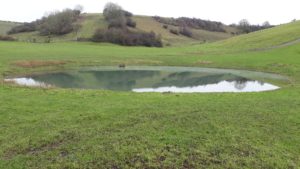Restoring dew ponds to create new habitats for birds and insects
February 8, 2021
Work is under way on restoring a dew pond to create an oasis for birds and aquatic insects.
The South Downs National Park Authority has partnered with the Norfolk Estate on a nature recovery project to reinstate a wetland habitat at Peppering, near Arundel.
Dew ponds are synonymous with the chalk grassland of the South Downs, historically being dug by farmers as a watering hole for livestock and some dating back at least a couple of hundred years.
These pretty ponds are also havens for all manner of species, explains Central Downs Ranger Simon Mockford.

“Dew ponds are oases for wildlife, providing drinking and bathing water for birds, and a home for dragonflies and other aquatic invertebrates,” says Simon.
“They also make good breeding sites for frogs, toads and newts. According to Pond Conservation small clean water ponds such as dewponds can be exceptionally rich wildlife habitats.
They typically support around 70 per cent of all freshwater species found in lowland landscapes. The wildlife value of ponds is also considerably enhanced where you have a network of them, making it easier for species to move between them, meaning populations are more resilient local climate change.”
The Authority is looking at creating a network of ponds in the area.
 Claire Kerr, Countryside Policy Manager, who is helping to lead the National Park’s Nature Recovery strategy, said: “This is a great example of partnership working to give a real boost to nature.
Claire Kerr, Countryside Policy Manager, who is helping to lead the National Park’s Nature Recovery strategy, said: “This is a great example of partnership working to give a real boost to nature.
“With biodiversity under threat across the world, it’s these kind of grassroots initiatives, creating new habitat and stronger ecosystems, that will make such a difference as part of a network of nature recovery projects.”
Main image by Tim Squire
